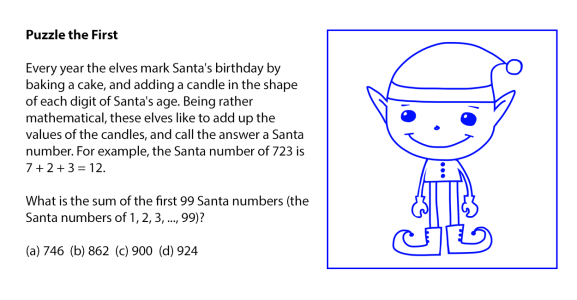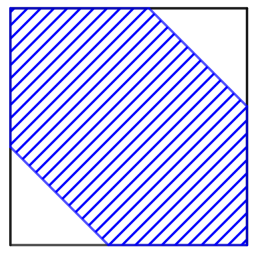There is no doubt about it, Santa is a mathematician. He must be, having every year to calculate the best way to get presents to so many homes in such a short space of time.
So in homage to such genius, we have two Santa themed puzzles for you to solve. You can find the answers at the bottom of the page (but try not to look too quickly).
Puzzle the First
Every year the elves mark Santa's birthday by baking a cake, and adding a candle in the shape of each digit of Santa's age. Being rather mathematical, these elves like to add up the values of the candles, and call the answer a Santa number. For example, the Santa number of 723 is 7 + 2 + 3 = 12.
What is the sum of the first 99 Santa numbers (the Santa numbers of 1, 2, 3, ..., 99)?
(a) 746 (b) 862 (c) 900 (d) 924
---
Puzzle the Second
One of Santa's elves has a tricky parcel to pack. Its shape is a hexagon, with all sides of equal length. The elf has placed the parcel inside a square of side length 1, as shown in the diagram. What is the length of one of the hexagon sides?
(a) \( \sqrt{2}-1 \) (b) \( 2 - \sqrt{2} \) (c) 1 (d) \( \frac{\sqrt{2}}{2} \) (e) \( 2 + \sqrt{2} \)
The solutions:
Don't look yet!
Not yet...
Okay, you can scroll down now.
-
-
-
-
-
Puzzle the First - Solution
Imagine the candles in a pile. 1 to 9 occur 10 times each as units digits, for example 1 is the last digit of 1, 11, 21, …, 91. And they occur 10 times each as tens digits, for example 1 is the first digit of 10, 11, 12, …, 19. So the total is \((1+2+\dotsb+9) \times 20 = 45 \times 20 = 900\).
So the answer is (c).
Puzzle the Second - Solution
Say the hexagon has side length \( h \) (so certainly \( h < 1 \)). The right-angled triangle in the top right of the diagram has short sides both of length \( 1-h \), and hypotenuse of length \( h \) (it's a side of the hexagon), so, by Pythagoras's theorem, \( h^2 = (1-h)^2 + (1-h)^2 = 2 - 4h + 2h^2 \), so \( h^2 - 4h + 2 = 0 \). We can solve that using the quadratic formula, which shows that \( h = 2 \pm \sqrt{2} \). But we know that \( h < 1 \), so \( h = 2 - \sqrt{2} \).
So the answer is (b).
If you enjoyed these puzzles you will find many more like them on our Mathematics Admissions Test pages from where these two puzzles were taken and festively adapted by our very own Vicky Neale.



